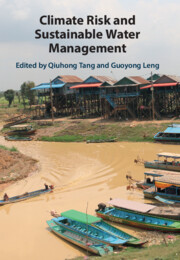Book contents
- Climate Risk and Sustainable Water Management
- Climate Risk and Sustainable Water Management
- Copyright page
- Contents
- Contributors
- Preface
- Acknowledgements
- Part I Water-Related Risks under Climate Change
- Part II Climate Risk to Human and Natural Systems
- 7 Observed Urban Effects on Temperature and Precipitation in Southeast China
- 8 Vegetation Dynamics, Land Use and Ecological Risk in Response to NDVI and Climate Change in Nepal
- 9 Climate Warming Induced Frozen Soil Changes and the Corresponding Environmental Effect on the Tibetan Plateau
- 10 A Review of the Effects of Climate Extremes on Agriculture Production
- 11 Agricultural Water Use Estimation and Impact Assessment on the Water System in China
- 12 Impact of Inter-Basin Water Transfer on Water Scarcity in Water-Receiving Area under Global Warming
- 13 Broadening and Deepening the Rainfall-Induced Landslide Detection
- 14 Estimating Aquifer Depth in Arid and Semi-arid Watersheds using Statistical Modelling of Spectral MODIS Products
- Part III Sustainable Water Management under Future Uncertainty
- Index
- References
10 - A Review of the Effects of Climate Extremes on Agriculture Production
from Part II - Climate Risk to Human and Natural Systems
Published online by Cambridge University Press: 17 March 2022
- Climate Risk and Sustainable Water Management
- Climate Risk and Sustainable Water Management
- Copyright page
- Contents
- Contributors
- Preface
- Acknowledgements
- Part I Water-Related Risks under Climate Change
- Part II Climate Risk to Human and Natural Systems
- 7 Observed Urban Effects on Temperature and Precipitation in Southeast China
- 8 Vegetation Dynamics, Land Use and Ecological Risk in Response to NDVI and Climate Change in Nepal
- 9 Climate Warming Induced Frozen Soil Changes and the Corresponding Environmental Effect on the Tibetan Plateau
- 10 A Review of the Effects of Climate Extremes on Agriculture Production
- 11 Agricultural Water Use Estimation and Impact Assessment on the Water System in China
- 12 Impact of Inter-Basin Water Transfer on Water Scarcity in Water-Receiving Area under Global Warming
- 13 Broadening and Deepening the Rainfall-Induced Landslide Detection
- 14 Estimating Aquifer Depth in Arid and Semi-arid Watersheds using Statistical Modelling of Spectral MODIS Products
- Part III Sustainable Water Management under Future Uncertainty
- Index
- References
Summary
Agricultural production is expected to double by 2050 in order to satisfy the increasing demand for food, feed and bioenergy. However, under climate change, the frequency and magnitude of climate extremes are expected to increase and represent a future threat to food security by reducing crop growth and yield. Therefore, understanding the effects of climate extremes on crop production is essential to inform effective adaption and mitigation strategies to ensure future food security. This paper aims to review the mechanisms behind the climate impacts on crop yield and summarize the effects of climate extremes on agricultural production reported in the literature. Heat extremes and drought are found to increase frequently, and the impacts of climate extremes on crop growth mainly occur during the anthesis and grain filling stages, leading to final crop yield loss. Many approaches have been adopted to assess the effects of climate extremes on crop yield, each with its own strengths and weaknesses. Adaptation measures are encouraged to mitigate crop loss risk in the future, when more frequent and severe climate extremes are projected to occur in agricultural areas.
- Type
- Chapter
- Information
- Climate Risk and Sustainable Water Management , pp. 198 - 219Publisher: Cambridge University PressPrint publication year: 2022
References
- 1
- Cited by

